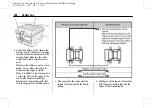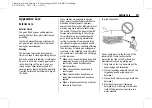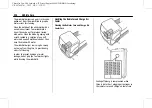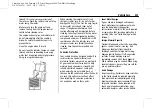
Chevrolet Low Cab Forward 6.7L Diesel Engine 6500XD (GMNA-Localizing-
U.S.-15749874) - 2022 - CRC - 12/2/21
240
Vehicle Care
1. Sidewall surface
2. Gap between inner and outer tires
3. Tread
Check the tread and sidewall surfaces of
each tire for cracks or other damage.
Especially check the tread for nails or other
metal pieces embedded in grooves and also
the gap between the inner and outer tires
of a dual-tire wheel for pebbles lodged in it.
When checking tires, pay special attention
to: low air pressure; pebbles or nails in
tread grooves; cracks or other damage on
tire surfaces; uneven wear; and pebbles
lodged in the gap between tires of
dual-wheel tires.
Tread Depth and Abnormal Wear
Tread wear indicator position mark (Example)
Tread wear indicator (Example)
1. Lug pattern
2. Rib pattern
Using worn-out tires is dangerous because
they might have an increased chance of
getting punctured or bursting while driving.
Check all tires to see if tread wear indicators
appear on their treads and also check their
entire tread for its depth with a depth
gauge to make sure that the grooves are
deeper than the specified depth. A tire with
tread wear indicators appearing must be
changed. Also, check the tires for uneven or
otherwise abnormal wear.
{
Warning
Tires with excessively shallow tread
grooves will increase the chance of
skidding and hydroplaning and may
result in a crash.
Hydroplaning occurs when a vehicle is
running at high speeds on a wet road and a
layer of water forms between the road
surface and tires causing the tires to float
on it. Hydroplaning prevents the driver from
steering correctly and from slowing down
the vehicle with the brake pedal.


































